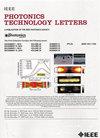Low-Loss and Robust Arc-Discharge Fusion-Splicing Between Anti-Resonant Hollow-Core Fibers
IF 2.3
3区 工程技术
Q2 ENGINEERING, ELECTRICAL & ELECTRONIC
引用次数: 0
Abstract
Fusion splicing between anti-resonant hollow-core fibers (AR-HCFs) is the key enabler that opens practical applications of those fibers in low-latency and low-loss fiber optical communication. Here, the impact of angular misalignment and fiber overlap on the splicing loss, higher-order modes (HOMs) excitation, and polarization-dependent loss (PDL) of commonly-used AR-HCF with 5-nested tubes are comprehensively characterized. Simulation and experimental results reveal that the misalignment angle can introduce a maximum coupling loss of 0.12 dB while having almost no impact on HOMs excitation and PDL variation. Then, under the condition of perfect angular alignment, the parameter of fiber overlap during the splicing is optimized, and an average splicing loss of 0.05 dB over 10 times experiment is obtained, which is equivalent to the loss result of standard single mode fiber (SSMF) splicing. Spectral analysis shows that the normalized LP11 mode power has a slight increase from -31.62 dB to -28.33 dB, and the variation in PDL is less than 0.01 dB under the optimal fiber overlap of抗共振中空芯纤维间的低损耗、稳健放电弧熔接技术
抗谐振空心芯光纤(ar - hcf)之间的融合拼接是打开该类光纤在低延迟、低损耗光纤通信中实际应用的关键因素。本文全面表征了角度失调和光纤重叠对常用AR-HCF的拼接损耗、高阶模态(HOMs)激发和极化相关损耗(PDL)的影响。仿真和实验结果表明,不对准角可导致最大0.12 dB的耦合损失,而对HOMs激励和PDL变化几乎没有影响。然后,在完全角对准的条件下,对拼接过程中的光纤重叠参数进行优化,在10次实验中得到的平均拼接损耗为0.05 dB,与标准单模光纤(SSMF)拼接的损耗结果相当。光谱分析表明,归一化后的LP11模式功率从-31.62 dB增加到-28.33 dB,且在最佳光纤重叠量为$8~\mu $ m时,PDL的变化小于0.01 dB,说明AR-HCF薄管在熔接过程中没有引起结构变形。此外,通过标准证明测试来检查拼接的机械稳健性,返回250 gf @1 s的损伤阈值。我们提出的融合剪接技术可以扩展到各种ar - hcf,提供ar - hcf之间的低损耗、鲁棒性和可重复互连的好处。
本文章由计算机程序翻译,如有差异,请以英文原文为准。
求助全文
约1分钟内获得全文
求助全文
来源期刊

IEEE Photonics Technology Letters
工程技术-工程:电子与电气
CiteScore
5.00
自引率
3.80%
发文量
404
审稿时长
2.0 months
期刊介绍:
IEEE Photonics Technology Letters addresses all aspects of the IEEE Photonics Society Constitutional Field of Interest with emphasis on photonic/lightwave components and applications, laser physics and systems and laser/electro-optics technology. Examples of subject areas for the above areas of concentration are integrated optic and optoelectronic devices, high-power laser arrays (e.g. diode, CO2), free electron lasers, solid, state lasers, laser materials'' interactions and femtosecond laser techniques. The letters journal publishes engineering, applied physics and physics oriented papers. Emphasis is on rapid publication of timely manuscripts. A goal is to provide a focal point of quality engineering-oriented papers in the electro-optics field not found in other rapid-publication journals.
 求助内容:
求助内容: 应助结果提醒方式:
应助结果提醒方式:


